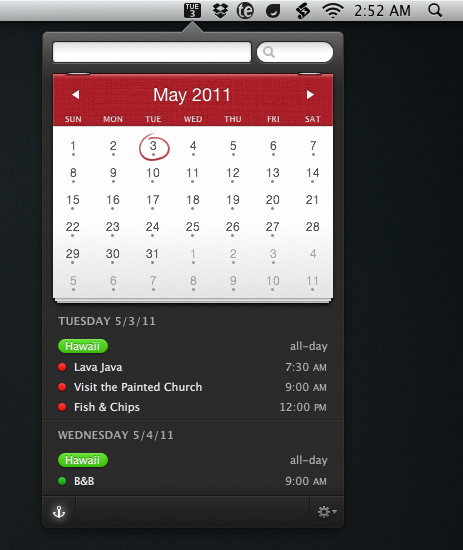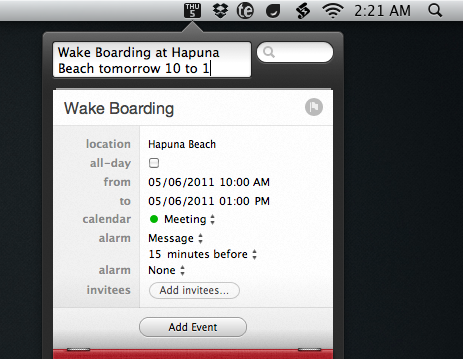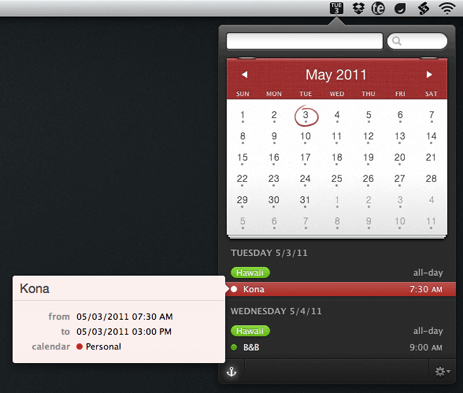Great spoof by Marvel.
Month: May 2011
Fantastical Preview
For the past several weeks I have had the privilege to beta test the soon-to-be-released Mac calendar app, Fantastical. It is still in private beta, and is due out later this month.
The developers over at Flexibits have given me permission to share a little bit about Fantastical with you guys, and I’m honored to do so because I am really loving this app.

There is a fine line between not enough and just enough — between usability and unnecessary lack. That line is defined in part by the developer but also by the user.
We, the users, define what is too much, not enough, or just right for the software we use. Often times, the best of developers will be able to aptly build in the appropriate features for all sorts of users. So that those users with less needs do not feel overwhelmed and those with more needs do not feel any lack.
In many ways I think Fantastical has hit that sweet spot.
Fantastical started out with the intentions of being a counterpart to your current calendar app. It syncs with iCal, Entourage, BusyCal, Google Calendar et al., and it works quite well as a nimble access point for viewing and adding new events.
Other plugins and utilities have sought to do this in the past. However, in all my years of experimenting with those various “helper” apps for iCal, none have ever stuck with me. Fantastical is the first one that has.
After daily usage for the past several weeks I have found that Fantastical is near wholly a stand-alone calendar app. The only thing it doesn’t do (yet) is allow you to edit an event once it’s been created. If you’re not always editing events, then Fantastical very well could replace iCal for most of your day-to-day calendaring needs. It has for me.
What I like most about Fantastical is how quick and accessible it is. It lives in your Menu Bar and you invoke it via a global hotkey (I use command+option+c), or by clicking on the Menu Bar icon, and it appears instantaneously. It is both keyboard and mouse friendly. The power users in the room will be glad to know you can navigate and operate the app without leaving the keyboard — if it were not so then I certainly would not find the same amount of utility from the app.
And what blows me away every time I use it is the entry panel for an event — Fantastical uses a natural language parser in addition to the standard new-event, iCal interface. So far, in my usage, the natural language parsing has been superb; the best I’ve ever used.

The parsing is not only good at actually understanding what I’m entering it also makes me feel quite confident that it understands me. There are some clever visuals that come to life as you type in the title, time, and location of your event. The words move to their corresponding spot in the date and time list, letting you know that the event is being created.
Fantastical is set to launch later this month. You can sign up on the teaser site if you want to be notified via email once it launches.
Popular is Overrated →
Seth Godin:
But in general, the search for popular is wildly overrated, because it corrupts our work, eats away at our art and makes it likely we’ll compromise to please the anonymous masses.
Byword →
Lately I’ve been writing the initial drafts of my longer-form articles using Byword and I really like it. Its glory is that it’s a very simple application.
When you work on a 23-inch monitor a good full-screen writing app can be hard to find. Apps that look good in full-screen mode on a 13- or 15-inch screen don’t necessarily scale well to 23 inches. Byword, however, scales quite well. It looks great regardless of if I’m writing on my laptop display or my cinema displays. And the dark color scheme is just splendid.
And the latest version (1.1.1) which shipped just about a week ago now includes autosaving and QuickCursor support among other improvements.
‘Keeping it Straight’ →
Patrick Rhone has just published his first book: Keeping it Straight. I’ve read it, and I enjoyed it. Patrick does a lot of things — he’s an entrepreneur, a tech consultant, a speaker — but first and foremost, Patrick is a writer.
New iMacs Can Be Used as External Displays via Thunderbolt →
Dan Moren for Macworld:
Apple has confirmed to Macworld that the new iMacs can be used as external displays via their Thunderbolt ports. However, to do so, you’ll need a Thunderbolt-equipped Mac, such as one of the early 2011 models of MacBook Pros.
How the Space and Color of a Room Affects Creativity and Focus →
High ceilings, open areas, and light colors help to foster creativity. Lower ceilings, tighter areas, and darker colors help with focusing in on detail-oriented tasks.
So is this why I usually am the most inspired and creative in the morning when the early light is in my office, and I am more productive at getting those ideas hammered out into something written during the evenings when it’s just the desk lamp providing light? And is this why we get outside when we just need to think, and we burn the midnight oil on that project because that’s when we’re finally in the zone to get things done?
Also, I’m curious if a similar study has been done regarding music and background noise and which types foster creativity and which types help with doing focused, detail-oriented work. This article about working at coffee shops because they’re “just enough distraction” is somewhat along that vein, but not quite.
Designing Graceful, Gracious, Interfaces for iPad →
Very excellent video presentation by Omni Group’s UX lead, Bill Van Hecke, talking about things they’ve learned porting their desktops apps for the iPad. Bill also shares some of the initial UI sketches and reasonings behind the OmniFocus iPad app. (Via Brent Simmons.)
iCloud Predictions
Last October I wrote about the potential of MobileMe:
When MobileMe re-branded and re-launched in July 2008 it was somewhat of a disaster. In an internal email to Apple employees, Steve Jobs said that “The vision of MobileMe is both exciting and ambitious.”
In its current state as “exchange for the rest of us” MobileMe seems neither exciting nor ambitious. As a web-app, me.com is beautiful and extremely functional. But I for one never use it. Instead I use the native OS X apps. And iDisk? Well, that is also collecting dust.
What would be exciting is an open service that bridged the gap for all the data which is shared between our Macs, iPhones, and iPads. What could be more ambitious than killing the USB cable?
Software development is no longer a contained relationship between a single piece of hardware and the software installed on it. Just as people who are serious about software should make their own hardware, people who are serious about mobile software should make their own cloud.
We know Apple is serious about mobile software and hardware, and it looks like they are getting ready to prove that they’re also serious about the cloud.
There have been many rumors about an iTunes digital locker, a rebranding of MobileMe, and a major software / hardware announcement in the fall. It is exciting to think that in the next several months we may see some significant new software products from Apple.
And so, as any respectable Apple-centric blogger knows, it’s part of the job description to post wild speculations about what we think will happen and when. Below you will find my iCloud predictions.
iCloud
Here’s an unordered list of what I think iCloud will look like in 2011:
- iTunes Music Locker: Available at a subscription cost, you can use iCloud to store your songs and movies in the cloud and then stream them to any computer or device running iTunes or iOS, such as your Mac, Apple TV, iPhone, iPod touch, and iPad.1
I see this as being one of two premier features of iCloud touted at WWDC. I also imagine it will be one of the main focal points of the September iPod event.
- Syncing of 3rd-party app data: Free for everyone with an Apple ID and part of the iOS 5 SDK announced and made available on June 6.
I see this as being the other premier features of iCloud when announced at WWDC. Because this will allow 3rd-party developers to use iCloud as a server so users can sync an app’s information between multiple iOS and Mac devices.
It will be great for Developers and could replace what Dropbox has become for apps like 1Password and the multitude of note-taking applications that use Dropbox for sharing of text documents.
This feature will also be huge for the average user. All they’ll need is their Apple ID and they can set up their app to sync with their other iOS devices.
- Contacts, calendar, and bookmarks: Just like it works in MobileMe right now, but it will become free for everyone with an Apple ID.
-
Find My iPhone: Will continue to be free for everyone with an Apple ID, just like it already is.
-
iBooks Syncing: Will continue to be free for everyone with an Apple ID, just like it already is.
-
Email: The @me.com email addresses will still be available but at a subscription cost like they currently are within MobileMe. However, I suspect the cost of a subscription will be less than the current pricing of MobileMe’s $99/year.
-
File-storage: 2 GB for free and meant for sharing and accessing your documents on multiple computers and iOS devices. More than 2 GB for a price.
I don’t think iCloud will be a Dropbox killer as nerds and power users like us might think. It may be one day, but Apple is focusing on making mobile apps and data stay in sync more than they are worried about improving how nerds and power users like us move, share, and sync our large working docs.
In short, it’s likely that we will keep on using Dropbox just like we always have been.
- Wild Card: iWork.com and the iWork suite: I have no idea if Apple will address the nightmare that is file-syncing and file-sharing of iWork documents between your Mac and iPad. I could totally see them making this simple and cloud-based as soon as Lion or as late as iOS 5, but I could also see them completely ignoring it for now.
iCloud Pricing
My guess is that there will be two pricing plans for iCloud: free and paid.
The free features, available to everyone with an Apple ID, will include the basic syncing services (contacts, calendars, bookmarks, 3rd-party apps) and small amount of file storage for sharing documents between devices.
The paid service will include the above, as well as the iTunes storage and streaming, email addresses, and extra storage. And I bet the price is dropped from $99/year to something closer to $49.
Rollout Schedule
Here are my wild guesses of when I see these features being rolled between now and the end of the year:
- June 6: iCloud announced at WWDC; new beta of Lion; beta of iOS 5 and corresponding SDK
At the June 6 keynote of WWDC I suspect we’ll see a preview of iOS 5, an announcement of iCloud, and an explanation of how integral iCloud will be in bringing OS X and iOS together.
It’s also likely that the iOS 5 beta will be made available for devs, and the updated SDK will allow for 3rd-party devs to utilize iCloud in their apps, and allow users to sync their app data between multiple iOS devices using their Apple ID.
- July / August: Lion Ships
Lion is scheduled to ship this summer we may see it in July, but I wouldn’t be surprised if it shipped in early August. Apple has never shipped a version of OS X in June or July — 5 of the 7 major public releases of OS X have shipped in the fall (August, September, or October).
I expect that iCloud will first become available to the public as part of Lion and include the basic OTA Mac to Mac syncing and perhaps OTA Mac to iPhone syncing.
It’s probably that the iTunes locker will ship with iTunes on Lion. While it seems to make more sense that this feature would ship in September along side the music-centric iPod event, I think Apple is chomping at the bit to get iTunes streaming out to the public. Who knows, maybe it’ll come as a major update to iTunes in June.
- September: iOS 5 Ships
Since the September iPod event is always focused around iPods and music, in some ways it makes sense that this is when the iTunes Music Locker feature is rolled out. But, as I said above, I think Apple wants iTunes streaming out sooner than the Fall.
I think the September event will focus on iOS 5 and will be the final stage of the iCloud rollout. This is when we’ll see the iTunes streaming come to our iPhones, iPads, and iPod touches, and hopefully our Apple TVs as well.
- Something else interesting about iCloud and the storage of our online media is that it would make Solid State Drives much more reasonable. I would not be surprised if the MacBook lineup got a refresh sometime this fall after Lion comes out and all of Apple’s notebooks begin shipping with SSDs as the default. ↵
[Sponsor] KanjiPictoGraphix: Essential Kanji Mnemonics →
KanjiPictoGraphix: Essential Kanji Mnemonics from Renkara Media Group brings a visually stunning new way to learn Japanese to the App Store. This application contains gorgeous mnemonic visuals, stroke order diagrams, vocabulary words, and a dynamic filtering and sorting system that makes discovery a delight.
Based on Michael Rowley’s Kanji Pict-O-Graphix book, the application brings enhanced color images and animated presentation to this award-winning favorite.
“Michael Rowley has created a visual vocabulary that is striking and, most importantly, memorable.” — Wired Magazine
Coming soon to iPad, iPhone, and iPod touch. Check out the video and sign up to be notified when the app is released!
Summary of Amazon’s lengthy outage →
Nice summary on Ars Technica by Peter Bright regarding what led to the Amazon EBS outage on April 21. Amazon’s lengthy (5,600 words) description is available here.
Tools of the Writing Trade →
And here’s another good piece by Surat Lozowick, this one about the tools we use for writing. Isn’t it funny how easily we get caught up in the what and the why of writing (or anything creative for that matter) in the hopes to improve our work, all the while knowing that what will most affect our work for the better is to simply do it. We love to philosophize about writing and to study it and to think on it and to search out new tools to make writing more enjoyable, but we hate to shut up, sit down, and do some writing.
The Paradox of Value →
Surat Lozowick with some good additional thoughts in response to my article about the iPhone as a camera:
Expensive gear might perform better, but it also carries a much higher risk. Sometimes a cheap camera or an old guitar are enough — or even better.
Remarks by the President on Osama Bin Laden →
Transcript from president Obama’s address:
Tonight, we give thanks to the countless intelligence and counterterrorism professionals who’ve worked tirelessly to achieve this outcome. The American people do not see their work, nor know their names. But tonight, they feel the satisfaction of their work and the result of their pursuit of justice.
We give thanks for the men who carried out this operation, for they exemplify the professionalism, patriotism, and unparalleled courage of those who serve our country. And they are part of a generation that has borne the heaviest share of the burden since that September day.
The video of the president’s address is here.
